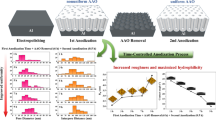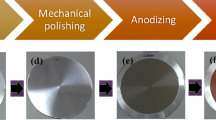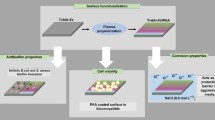We analyzed the ways of improvement of the functional properties of coatings on aluminum alloys obtained by the method of hard anodizing. It is shown that the protective properties of hard anodic coating are closely related to its porosity. In the course of pulsed anodizing, as a result of the efficient heat dissipation (removal) for a low current density, the diameter of pores decreases as compared with the process running under direct current, whereas their number remains invariable. This results in a higher wear resistance and a more uniform hardness profile over the thickness of the coating. It was established that, for too low current densities, the dissolution of oxides prevails over their formation. The hardness and wear resistance of the coating are deteriorated. It is shown that the most important mechanical property of the anodic coating is its wear resistance but not hardness. The most common electrolytes used for aluminum anodizing are aqueous solutions of sulfuric acid, as well as electrolytes based on sulfuric and oxalic acids. Various additives to electrolytes (e.g., glycolic acid and glycerol) are applied to reduce the dissolution of oxides. The use of ozone-air mixtures for the bubbling of electrolytes in the course of anodizing of aluminum alloys increases the thickness of oxide coatings by 30%. As the concentration of ozone increases, the microhardness of the coating becomes higher and the degree of wear of anodized specimens decreases. It is shown that the thickness and hardness of the oxide film can be increased by the preliminary heat treatment of cast aluminum alloy and the use of electrolytes with aluminum sulfate promoting the formation of a large number of fine Al2O3 crystals in the film and increasing hardness.






Similar content being viewed by others
References
N. D. Tomashov, M. N. Tyukina, and F. P. Zalivalov, Thick-Layer Anodizing of Aluminum [in Russian], Mashinostroenie, Moscow (1966).
E. E. Aver’yanov, Handbook on Anodizing [in Russian], Mashinostroenie, Moscow (1988).
I. N. Frantsevich (editor), Anodic Oxide Coatings on Metals and Anodic Protection [in Russian], Naukova Dumka, Kiev (1985).
M. Roshani, A. Sabour Rouhaghdam, M. Aliofkhazraei, and A. Heydari Astaraee, “Optimization of mechanical properties for pulsed anodizing of aluminum,” Surf. Coat. Technol., 310, 17–24 (2017).
L. Z. F. Li and R. M. Metzger, “On the growth of highly ordered pores in anodized aluminum oxide,” Chem. Mater., 10, 2470–2480 (1998).
C. Chung, W. Chang, M. Liao, H. Chang, and C. Lee, “Fabrication of enhanced anodic aluminum oxide performance at room temperatures using hybrid pulse anodization with effective cooling,” Electrochim. Acta, 56, 6489–6497 (2011).
P. Kwolek, D. Drapała, K. Krupa, A. Obłój, T. Tokarski, and J. Sieniawski, “Mechanical properties of a pulsed anodised 5005 aluminium alloy,” Surf. Coat. Technol., 383, 125–233 (2020).
T. Aerts, T. Dimogerontakis, I. De Graeve, J. Fransaer, and H. Terryn, “Influence of the anodizing temperature on the porosity and the mechanical properties of the porous anodic oxide film,” Surf. Coat. Technol., 201, 7310–7317 (2007).
I. Mohammadi, S. Ahmadi, and A. Afshar, “Effect of pulse current parameters on the mechanical and corrosion properties of anodized nanoporous aluminum coatings,” Mater. Chem. Phys., 490–498 (2016).
I. Mohammadi and A. Afshar, “Modification of nanostructured anodized aluminum coatings by pulse current mode,” Surf. Coating Technol., 278, 48–55 (2015).
M. Roshani, A. Sabour Rouhaghdam, M. Aliofkhazraei, and A. Heydari Astaraee, “Optimization of mechanical properties for pulsed anodizing of aluminum,” Surf. Coat. Technol., 17–24 (2017).
C. Lämmel, M. Schneider, C. Heubner, W. Beckert, and A. Michaelis, “Investigations of burning phenomena during the hard anodising of aluminium by local in-operando temperature measurements,” Electrochim. Acta, 249, 271–277 (2017); DOI: 10.106/ j.electacta.2017.07.167.
A. D. Juhl, “Why it makes sense to upgrade to pulse anodizing. Mock finishing shop scenarios show how switching from conventional anodizing processes to newer methods can boost productivity while maximizing ROI,” Metal Finishing, 107, No. 7-8, 24–27 (2009).
C. K. Chung, W. T. Chang, M. W. Liao, H. C. Chang, and C. T. Lee, “Fabrication of enhanced anodic aluminum oxide performance at room temperatures using hybrid pulse anodization with effective cooling,” Electrochim. Acta, 56, 6489–6497 (2011).
C. K. Chung, M. W. Liao, H. C. Chang, W. T. Chang, and T. Y. Liu, “On characteristics of pore size distribution in hybrid pulse anodized high-aspect-ratio aluminum oxide with Taguchi method,” Microsystem Technol., 19, 387–393 (2013).
A. Bozza, R. Giovanardi, T. Manfredini, and P. Mattioli, “Pulsed current effect on hard anodizing process of 7075-T6 aluminium alloy,” Surf. Coat. Technol., 270, 139–144 (2015).
V. Raj, M. P. Rajaram, G. Balasubramanian, S. Vincent, and D. Kanagaraj, “Pulse anodizing—An overview,” Int. J. Surf. Eng. Coat., 81, 114–121 (2003).
M. Sieber, R. Morgenstern, and T. Lampke, “Anodic oxidation of the AlCu4Mg1 aluminium alloy with dynamic current control,” Surf. Coat. Technol., 302, 515–522 (2016).
M. Bononi, R. Giovanardi, and A. Bozza, “Pulsed current hard anodizing of heat treated aluminum alloys: frequency and current amplitude influence,” Surf. Coat. Technol., 307, 861–870 (2016).
F. Jensen, C. V. Gudla, I. Kongstad, and R. Ambat, “High frequency pulse anodising of aluminium: Anodising kinetics and optical appearance,” Surf. Coat. Technol., 360, 222–231 (2019).
H. Shih and S. Tzou, “Study of anodic oxidation of aluminum in mixed acid using a pulsed current,” Surf. Coat. Technol., 124, 278–285 (2000).
P. G. Sheasby, R. Pinner, and S. Wernick, The Surface Treatment and Finishing of Aluminium and its Alloys, ASM Int., Trowbridge (2001).
P. Kwolek, K. Krupa, A. Obłój, P. Kocurek, M. Wierzbińska, and J. Sieni, “Alloy in the hard anodizing process,” J. Mat. Eng. Perform., 27, 3268–3275 (2018).
W. Bensalah, M. Feki, M. Wery, and H. Ayedi, “Thick and dense anodic oxide layers formed on aluminum in sulphuric acid bath,” J. Mater. Sci. & Tech., 26, 113–118 (2010).
Anodizing. Admixtures to the Electrolyte Based on Sulfuric Acid; http://vseokraskah.net/page 1.
W. Bensalah, K. Elleuch, M. Feki, M. Wery, and H. F. Ayedi, “Optimization of anodic layer properties on aluminium in mixed oxalic/sulphuric acid bath using statistical experimental methods,” Surf. Coat. Technol., 201, Issue 18, 7855–7864 (2007).
Specifications of the Anodizing of Aluminum on the Basis of Sulfuric Acid for Obtaining the Certificate of Conformance to Quality Standard QUALANOD, Publ. on 01.01.2020. QUALANOD, P. O. Box 1507, CH-8027 Zurich.
D. Zhang, Yi. Gou, Yu. Liu, and X. Guo, “A composite anodizing coating containing superfine Al2O3 particles on AZ31 magnesium alloy,” Surf. Coat. Technol., 236, 52–57 (2013)
R. Giovanardi, C. Fontanesi, and W. Dallabarba, “Adsorption of organic compounds at the aluminium oxide/aqueous solution interface during the aluminium anodizing process,” Electrochim. Acta, 56, No. 930, 3128–3138 (2011).
N. F. Kolenchin, “Influence of the technology of thick-layer anodizing of aluminum alloys on the properties of the coatings,” in: Uchen. Zapiski, Elektron Zhurnal Kursk Gos. Univ. (2012).
V. T. Belov, “Comparison of the hydration of phased aluminum oxide obtained in solutions of different electrolytes,” in: Anodic Oxidation of Metals [in Russian], Izd. KAI, Kazan (1983), pp. 39–45.
M.-H. Chiang, C.-C. Yeh, and C.-L. Lee, “Improvement in the abrasive wear resistance of an aluminum alloy casting for a continuously-variable transmission using heat treatment and pulsed anodizing,” Wear, 442-443, 203137 (2020).
B. Zhu, S. Seifeddine, P. O. A. Persson, A. E. W. Jarfors, P. Leisner, and C. Zanella, “A study of formation and growth of the anodised surface layer on cast Al–Si alloys based on different analytical techniques,” Mater. Des., 101, 254–262 (2016).
Author information
Authors and Affiliations
Corresponding author
Additional information
Translated from Fizyko-Khimichna Mekhanika Materialiv, Vol. 56, No. 6, pp. 87–95, November–December, 2020.
Rights and permissions
About this article
Cite this article
Student, М.М., Pohrelyuk, I.М., Chumalo, H.V. et al. Improvement of the Functional Characteristics of Coatings Obtained By the Method of Hard Anodizing of Aluminum Alloys. Mater Sci 56, 820–829 (2021). https://doi.org/10.1007/s11003-021-00500-x
Received:
Published:
Issue Date:
DOI: https://doi.org/10.1007/s11003-021-00500-x




